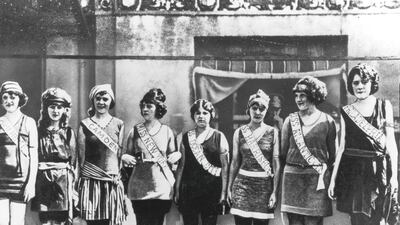"We are no longer a pageant. We are a competition," Gretchen Carlson, head of the board of trustees of the Miss America Organisation said last week, dividing opinion as it also ditched its well-known swimwear parade. "We will no longer judge our candidates on their outward physical appearance," continued Carlson, who was herself crowned Miss America in 1989. "That's huge."
The change will allow the organisation to respond to the “cultural revolution” and talk about rewarding women for their “social impact initiatives”, she said, rather than their ability to execute a runway turn in killer high heels and a bikini.

It's also an attempt to publicly detoxify the Miss America brand. Its chief executive Sam Haskell, among others, was forced to resign last December after a series of offensive emails written about former competitors was made public. The widely reported scandal followed allegations made during the 2016 US presidential election that Donald Trump, who'd boasted of sexually assaulting women, had frequently entered the Miss Teen USA dressing room when girls were in various stages of undress.
Trump once owned the Miss Universe Organisation, which ran the eponymous international pageant alongside Miss USA and Miss Teen USA; all three rivals for public attention with the Miss America pageant.
All of a sudden beauty contests had begun to look like the unsavoury exercise of male power and female objectification that the #MeToo and #TimesUp movements were noisily and successfully disemboweling in the US entertainment and media industry. But if anything, the headlines only brought Miss America closer to the salacious impulses that have informed beauty pageants throughout their history.
In the original beauty contest, beauty itself – in the form of the peerless Helen – is the reward offered to the Trojan prince Paris for declaring Aphrodite, the goddess of love more lovely than her competitors Athena, goddess of warfare and wisdom or Hera, the goddess of marriage. His real prize is not permission to kidnap the beautiful wife of King Menelaus, however; but the infamy of causing the Trojan War.
American entrepreneurs were undeterred by the unsubtle lesson offered by classical mythology, preferring to realise the commercial potential of using women’s bodies to promote seaside resorts in the 1920s. American newspapers had been running beauty contests based on readers’ photographs for decades, and they had proved to be hugely popular, but it took an acceptance of public bathing for parades of live flesh to really get moving.
One of the first beach contests to feature a “Bathing Girl Revue” was organised in Galveston, Texas, in 1920 to mark the start of the summer tourist season. By 1926, the event attracted contestants from other countries and a “Miss Universe” of sorts was crowned.
Black and white archive footage of the coastal resort city’s competition from that year shows women in skirted one-piece swimming costumes twirling parasols on the sand while a few are even wearing socks with their sensible low heels. All appear to agree that it’s jolly good fun to stand on the back of an automobile and drive waving through crowds of beachgoers.
In fact it’s all incredibly jaunty and innocent-seeming compared to the strutting swimwear section of previously televised Miss America contests, which owe more to a Victoria’s Secret catwalk show than any notion of outdoor fun and fitness that seaside breaks in Galveston once espoused.
Miss America itself began life as part of Atlantic City’s Fall Frolic in September 1921, designed to boost tourist numbers at the tail end of the season.
As The New York Times took time to report, it was hugely successful: "1,000 BATHING GIRLS ON VIEW IN PAGEANT; 150,000 See Picked Beauties in One-Piece Suits in Atlantic City's Fall Event. 8 MILES OF ROLLING CHAIRS People From 100 Cities Guests at Governor's Ball, Which Closes Celebration".
The following decade found beauty contestants competing for Hollywood’s attention and unfortunate notoriety as newspapers called out bribery and corruption at contests up and down the east coast. Hollywood exported the idea of beauty contests to new audiences in Hawaii and Cuba in the 1920s and 1930s, according to academic research, and also back to the United Kingdom, which had its own centuries-old tradition of crowning May Queens during May Day festivals.
Judges only really became interested in what the parading women thought and said in 1938, when the Miss America pageant added a mandatory scoring talent section. Today’s Miss America Organisation hands out education grants to winners and claims to be the largest provider of such scholarships to young women in the US.
A quick strut through the history of American beauty contests only underlines how static the format has been. It also explains Carlson’s claim that the changes to the current Miss America contest are “huge”. That a greater focus on intellectual accomplishment and disdain for Lycra should have caused such comment and protest suggests that mainstream US audiences are somewhat behind worldwide trends.
Last month, model Halima Aden graced the gatefold cover of the hitherto conservative fashion magazine British Vogue wearing a hijab, flanked by a line-up of models from different racial and ethnic backgrounds above a cover line that read: "New Frontiers".

Aden, a Somali-American, once competed to become Miss Minnesota USA wearing her hijab and a burkini in the pageant’s swimwear section. The 19 year-old reached the semi-finals of the rival contest to Miss America in November 2016.
Compare this to the grainy Universal Newsreel footage of women auditioning for the state of Texas’s 100 Year Pageant in 1935, which shows women stepping into wooden cutouts to prove their “degree of pulchritude”. One is literally forced into a silhouette by the foot of another on her swimsuited backside; it’s brutal when you don’t measure up. Aden shows that even in the unreconstructed world of beauty pageants, notions of physical beauty have had to become less rigid as societies and markets have become more diverse.
The idea that “beautiful” women come in all shapes, colours and sizes with different interests, ambitions and achievements is slowly beginning to gain more widespread acceptance. So, it seems, women are just like men after all; a conclusion that begs the question, ‘What next?’.
In the name of equality and the “cultural revolution”, will we ever see men competing alongside women in some future Mr America competition for the chance of winning an education scholarship? No, but that really would be “huge”.
_________________
Read more:
Miss America pageant cancels swimwear and evening gowns categories
Hijabi student makes it into the Miss Universe finals in New Zealand
Miss America president resigns after email scandal
_________________


